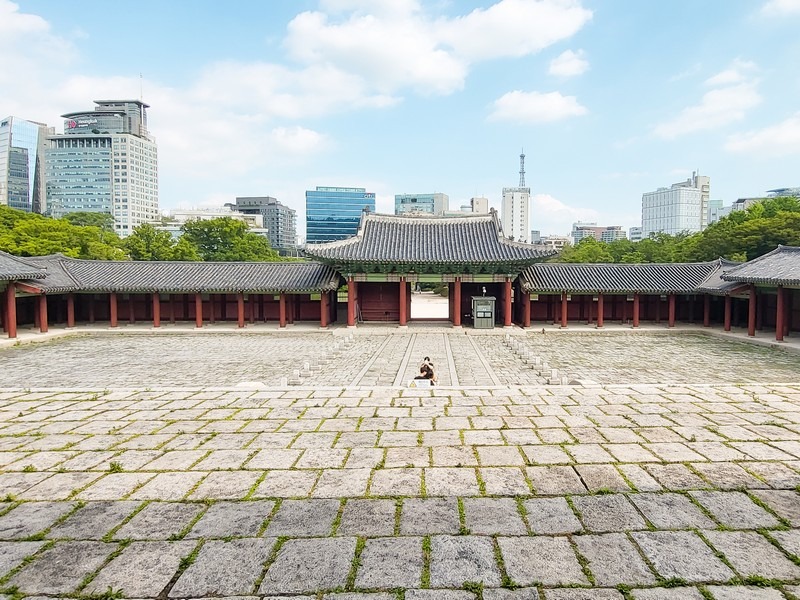Gyeonghuigung Palace: The Smallest Palace In Seoul
Last Updated on April 4, 2024
You can walk up Yulgok-ro and see three palaces in one day if you really wanted to here in Seoul, those being Gyeongbokgung, Changdeokgung and Changgyeonggung. Or walk down Saejong Dae-ro from Gyeongbokgung passing Gwangwhamun and find your fourth palace, Deoksugung Palace. But there’s a fifth smaller and lesser known, and probably for that reason, free palace known as Gyeonghuigung (경희궁) in the vicinity as well.
It’s not in the very touristy area as the others, but a lovely place to meander without the crowds too. Its name translates to Palace of Serene Harmony and it truly lives up to the name with so few visitors meandering around.

Plan a trip to the smallest palace in Seoul:
- How To Get There
- Basic Info
- History of Gyeonghuigung Palace
- What To See
- Should You Visit Gyeonghuigung Palace
(This post contains affiliate links, which means I receive a certain percentage of a sale if you purchase after clicking. Thank you for your support.)
How To Get There
Address: 1 Sinmoon-ro 2-ga Jongno-gu, Seoul (서울특별시 종로구 신문로2가 1)
By Public Transportation: Seodaemun Subway Station, exit 4 and walk straight.
Basic Info
Days: Closed Mondays and January 1st
Hours: Tuesday – Sunday: 9:00am ~ 6:00pm
Admission: Free
History of Gyeonghuigung Palace
Construction of Gyeonghuigung began in 1617 and was completed in the 15th year of the reign of Gwanghaegun in 1623. Known as the west palace now, but officially recognized as a royal villa during the Joseon period, the palace was enjoyed by some ten Korean kings. Before it was built, the grounds were the house of Jeongwon-gun, Injo’s father.

Gyeonghuigung Palace was originally comprised of over 100 halls, but unfortunately most of them were burnt down either during the 29th year of King Sunjo, in 1829. Rebuilt, there was again destruction during the 20th year of the reign of King Gojong and then later the remaining halls were burnt down during the Japanese colonial period so that schools could be built on the site for Japanese children.
After the liberation in 1946, Seoul High School was built on the site and remained there until 1978. Finally, in 1985 the Seoul city government decided to reconstruct the palace grounds and restoration began. However, it was not to be as illustrious as it once was.
The area that was once immense and only for the palace had been invaded by urban growth and there was not as much space for the government to rebuild. Only 33% of the former palace has been reconstructed since then.

What To See
In its heyday, the palace was vast, but unfortunately today, it’s much smaller than it once was. Interestingly, the main hall that sits on the grounds, Sungjeongjeon, is a replica that was built in 1987 as the original had been moved to Dongguk University and was deemed too old to be moved again.
Here is where the king would hold morning meetings and ceremonies as well as banquets and receptions for important foreign visitors and officials. The inauguration ceremonies of King Gyeongjong, King Jeongjo, and King Heonjong were all held here.

The main gate, Heunghwamun, was moved and installed as the main gate for Bakmunsa, which is now the Shilla Hotel and was dedicated to Ito Hirobumi, a Japanese resident-general and four-time Prime Minister of Japan, before being relocated back at Gyeonghuigung in 1985.
Also on the grounds are Jajeongjeon Hall and Taeryeongjeon Hall. Jajeongjeon Hall was used by the king for meetings with royal council and as his sort of personal living room. After King Sukjong died in 1720, then this building became the binjeon, or the hall in the royal residence where the coffin of the king or queen was placed prior to burial.


Taeryeongjeon Hall, located in the back corner of the property, holds a portrait of King Yeongjo who ruled from 1724 until his death in 1776. This building didn’t really have a specific purpose originally, however, it’s unique now in that King Yeongjo dedicated his own portrait to be hung here during his reign. Previously, portraits of past kings would be hung.
Another area to find on the property is a large rock in the northwest corner with spring water trickling down. It is said that Seoam Rock and the spring were the reasons that Prince Gwanghae had the villa built here in the first place. Originally, the rock was known as Wangam or ‘King’s Rock’ but in 1708 it was renamed Seoam Rock meaning ‘Propitious Rock’. King Yeongjo was known to have spent quite a bit of time at the rock.

Should You Visit Gyeonghuigung Palace
Though the palace isn’t as conveniently located in the tourist area of Insa-dong and hasn’t received an UNESCO designation, it is still worth visiting. Though not huge, there are beautiful areas to take pictures and it’s often very quiet so ideal if you want pictures with a palace but don’t want the crowds of the other palaces.
A visit could also include the Gyeonghuigung Annex building of the Seoul Museum of Art which is also on the Gyeonghuigung Palace site. Additionally, the Seoul Museum of History, one of the more popular tourist sites in Seoul is just outside of the palace and houses a great permanent collection to see. You could also walk up the street to the Agricultural Museum which is great if you have kids.
Did you like this post? Pin IT!

